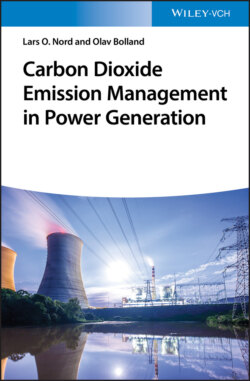Читать книгу Carbon Dioxide Emission Management in Power Generation - Prof. Lars O. Nord - Страница 26
1.11 History of CCS
ОглавлениеThe technology for separating gases using chemical absorption was developed in the 1940s (Siddique 1990) and thereafter developed for separating CO2 from gas mixtures. The purpose of separating CO2 from other gases was, among other things, the carbonation of drinks. The technology was developed for separating CO2 and other acid gases from natural gas (Kohl and Nielsen 1997). One of the first to suggest CCS was Marchetti (1977). He made reference to several methods for CO2 capture from power plants and blast furnaces, and he proposed storing the CO2 in the ocean. Marchetti worked for the International Institute for Applied Systems Analysis (IIASA) in Austria, where CCS was an issue being worked on during the 1970s. In 1980, Anthony Albanese and Meyer Steinberg published a paper with a very detailed discussion on capture technologies and energy use as well as storage (Albanese and Steinberg 1980). During the 1980s, Steinberg published a number of reports and papers dealing with CCS, and this is summarised in Steinberg (1992). Meyer Steinberg is the most obvious father of CCS, if one can use such a term, because of his contribution during the 1980s. Steinberg has published a large number of papers related to CCS and is also the co-author of a text book (Halmann and Steinberg 1999).
The Norwegians, Erik Lindeberg and Torleif Holt, did a lot of work on CCS in the late 1980s and were the initiators of CCS in Norway. A significant contribution was made by Wim Turkenburg, Kornelius Blok, and Chris Hendriks in the Netherlands, who, among other things, organised the First International Conference on Carbon Dioxide Removal (ICCDR) in Amsterdam in March 1992. ICCDR and the Greenhouse Gas Mitigation Options Conference were merged in 1997 to form the Greenhouse Gas Control Technologies (GHGT) conference series, which is now established as the main conference within CCS.
During the 1980s, work related to CCS took place at Oak Ridge National Laboratory (ORNL) and the Electric Power Research Institute (EPRI) (Steinberg 1992). There was also activity related to CO2 capture at the Argonne National Laboratory from the early 1980s (Abraham et al. 1982).
It was not until close to 1990 that the volume of research effort in this field was increased to a significant level. The Japanese, and in particular, the RITE (Research Institute of Innovative Technology for the Earth), were already doing extensive work in the early 1990s. The main focus of research in Japan was on CO2 fixation and utilisation.
In 1991, the IEA Greenhouse Gas R&D Programme (IEA GHG) was established. IEA GHG is an Implementing Agreement of the International Energy Agency. In January 2013, the IEA GHG consisted of 19 member countries, the European Commission, OPEC, and 21 multinational industrial sponsors. The IEA GHG is playing a very important role as a coordinator for R&D activities within CCS. The Intergovernmental Panel on Climate Change (IPCC) has been important for the development of the interest in CCS and in justifying the need for CCS, by pointing to the necessity both to reduce greenhouse gas emissions and to emphasise CCS as a mitigation option.
It is important to note that many CO2 capture plants were built and operated with removal of CO2 from natural gas and synthesis gas during the 1970s and 1980s. CO2 was also captured from the flue gas in a number of plants that were built in this time period in order to provide CO2 for EOR (refer to Section 2.1.2) as well as for other industrialised use (Pauley 1983; Barchas and Davis 1992; Sander and Mariz 1992; Suda et al. 1992). One can say that the technology for the capture of CO2 from gas streams was already available at the time the idea of CCS emerged.
